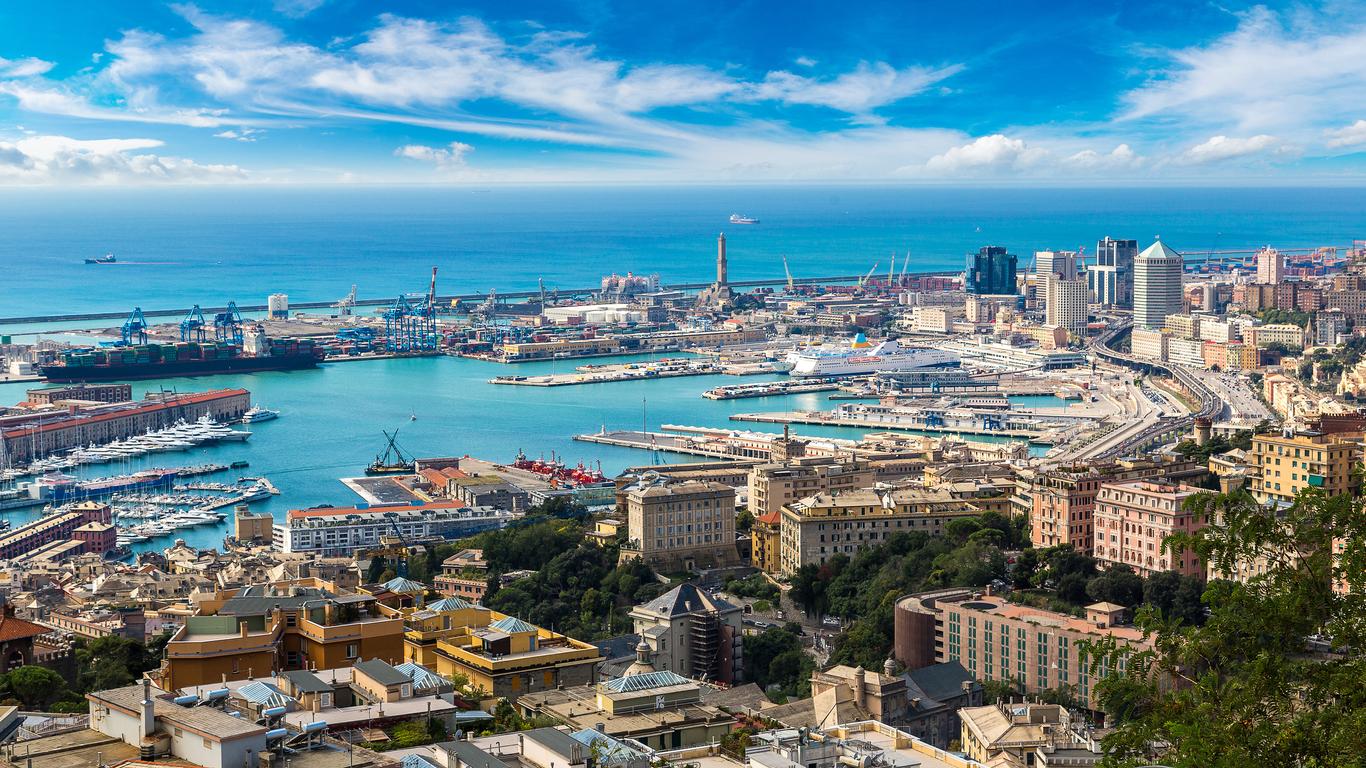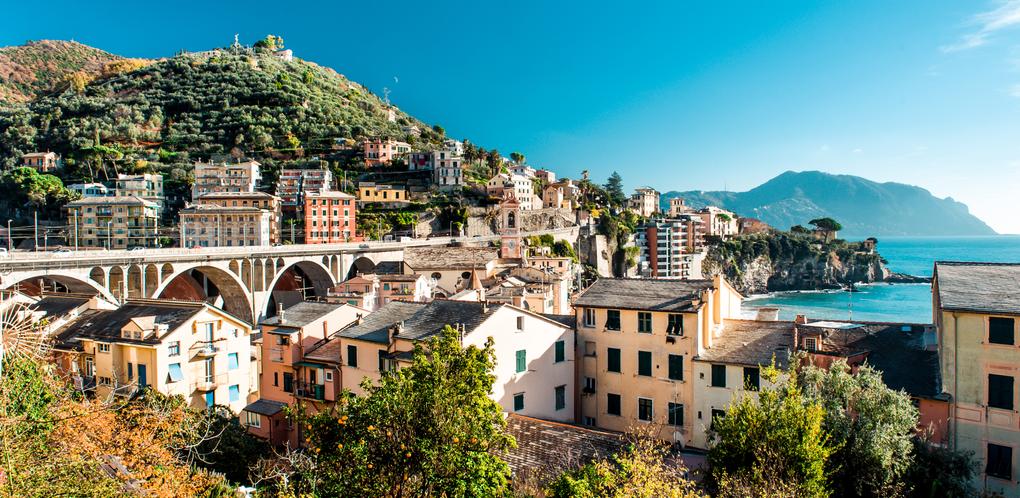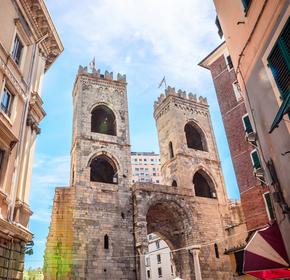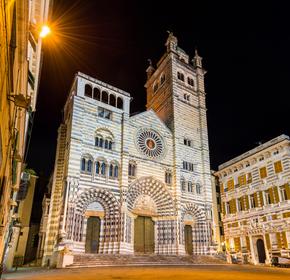
Genoa travel guide
Genoa Tourism | Genoa Guide
You're Going to Love Genoa
A great trading republic of the renaissance, the home port of Christopher Columbus, and in latter years a portal to the Italian riviera, Genoa is a fascinating jumble of grand historical palaces, modern attractions, and intriguing neighborhoods.

Top 5 Reasons to Visit Genoa
1. UNESCO-Listed Historical Sites
Genoa once dominated the Mediterranean, and its glory days have left a gorgeous legacy. See the exquisite Palazzo Reale, the Cathedral of San Lorenzo, and Ombre Rosse, a 13th-century medieval home.
2. Fabulous Art Galleries
A cluster of stately palaces forms the Musei di Strada Nuova - a trio of superb art galleries featuring countless masterpieces.
3. World-Famous Foods
When you visit, don't miss out on authentic Ligurian Pesto Genovese - the way it should be made - as well as ravioli in traditional walnut sauce.
4. Family-Friendly Modern Attractions
Genoa has something for every member of the family. The kids will adore the recently completed aquarium in the port district, while Biosfera offers a mixture of international plants as well.
5. It's a Gateway to Coastal Wonders
When you stay in Genoa, you'll be within striking distance of the Cinque Terre - a series of scenic coastal villages - as well as the resorts to the west.
What to do in Genoa
1. Piazza de Ferrari: An Amazing Historic Junction
Genoa's main square, the Piazza De Ferrari is nestled between the city's historic district and its fashionable downtown. Cesare Crosa of Vergagni designed the piazza's colossal bronze fountain in 1936. The square is surrounded by the Palazzo della Regione Liguria (the political hub of the region), the Ligurian Academy of Fine Arts (founded in 1741), the Teatro Carlo Felice (a neoclassic masterpiece housing the statue of Giuseppe Garibaldi) and the palace of the Palazzo Ducale that was named for Raffaele De Ferrari, the piazza's namesake.
2. Porta Soprana: The Gate to the City
La Porta Soprana, also known as Porta di Sant'Andrea, is one of the few surviving entrances of the Barbarossa walls, built from 1155 to 1159 in honor of the Swabian Emperor who conquered Milan and ordered the payment of taxes to Genoa. A plaque above the entrance hails Genoa's independence, and the gate is near the home of Christopher Columbus, now a museum. The home adjoins the 12th-century cloister of the monastery of Sant'Andrea.
3. Cattedrale di San Lorenzo: A Feast of Celestial Art
The Cattedrale di San Lorenzo is home to the Archbishop of Genoa. Consecrated by Pope Gelasius II in 1118, the cathedral features Romanesque, Mannerist and Gothic elements. The basilica houses frescoes by Luca Cambiaso, a Crucifixion with Saints by Barocci, an Episode from the life of San Lorenzo by Giovanni Andrea Ansaldo and an Assumption of the Virgin by Gaetano Previati as well as a Virgin and a St. John the Baptist by Andrea Sansovino among other works.
4. Palazzo Rosso: A Truly Royal Showcase
A historical palace in Genoa, Palazzo Rosso is one of the city's most renowned art galleries. Designed by Pietro Antonio Corradi and constructed between 1671 and 1677, the palazzo was owned by the Brignole Sale family until 1874, when it was bestowed to Genoa as an arts center. The space features 17th-century furnishings and frescoes as well as masterworks by Guercino, Strozzi, il Grechetto, Dürer, Veronese and Van Dyck among others.
5. Faro di Genova: The Beacon of Genoa (...and also once a prison!)
The Lighthouse of Genoa, also known as Lanterna, illuminates the city's port. The world's fifth tallest lighthouse was built in 1128 and features two square sections, each topped with a terrace. The tower, with three crenellated towers, was converted in 1400 into a prison. In 1543, the tower was rebuilt into its current incarnation. The lighthouse adjoins the Museo della Lanterna, which showcases the history of the city and the port.






1. Piazza de Ferrari: An Amazing Historic Junction
Genoa's main square, the Piazza De Ferrari is nestled between the city's historic district and its fashionable downtown. Cesare Crosa of Vergagni designed the piazza's colossal bronze fountain in 1936. The square is surrounded by the Palazzo della Regione Liguria (the political hub of the region), the Ligurian Academy of Fine Arts (founded in 1741), the Teatro Carlo Felice (a neoclassic masterpiece housing the statue of Giuseppe Garibaldi) and the palace of the Palazzo Ducale that was named for Raffaele De Ferrari, the piazza's namesake.
2. Porta Soprana: The Gate to the City
La Porta Soprana, also known as Porta di Sant'Andrea, is one of the few surviving entrances of the Barbarossa walls, built from 1155 to 1159 in honor of the Swabian Emperor who conquered Milan and ordered the payment of taxes to Genoa. A plaque above the entrance hails Genoa's independence, and the gate is near the home of Christopher Columbus, now a museum. The home adjoins the 12th-century cloister of the monastery of Sant'Andrea.
3. Cattedrale di San Lorenzo: A Feast of Celestial Art
The Cattedrale di San Lorenzo is home to the Archbishop of Genoa. Consecrated by Pope Gelasius II in 1118, the cathedral features Romanesque, Mannerist and Gothic elements. The basilica houses frescoes by Luca Cambiaso, a Crucifixion with Saints by Barocci, an Episode from the life of San Lorenzo by Giovanni Andrea Ansaldo and an Assumption of the Virgin by Gaetano Previati as well as a Virgin and a St. John the Baptist by Andrea Sansovino among other works.
4. Palazzo Rosso: A Truly Royal Showcase
A historical palace in Genoa, Palazzo Rosso is one of the city's most renowned art galleries. Designed by Pietro Antonio Corradi and constructed between 1671 and 1677, the palazzo was owned by the Brignole Sale family until 1874, when it was bestowed to Genoa as an arts center. The space features 17th-century furnishings and frescoes as well as masterworks by Guercino, Strozzi, il Grechetto, Dürer, Veronese and Van Dyck among others.
5. Faro di Genova: The Beacon of Genoa (...and also once a prison!)
The Lighthouse of Genoa, also known as Lanterna, illuminates the city's port. The world's fifth tallest lighthouse was built in 1128 and features two square sections, each topped with a terrace. The tower, with three crenellated towers, was converted in 1400 into a prison. In 1543, the tower was rebuilt into its current incarnation. The lighthouse adjoins the Museo della Lanterna, which showcases the history of the city and the port.






Where to Eat in Genoa
Genoa is a massive gastronomic destination, and the standard of eateries is high. Highlights include the 16th-century Le Cantine Squarciafico, the traditional fare at Le Cicale, and the burger specialists Il Masetto. Meals will cost about EUR30-40 with a bottle of wine included.
When to visit Genoa
May is a fantastic time to visit, with warm weather and relatively light crowds, but summer is just as good. The sea will be perfect for swimming and the long summer evenings seem made for al fresco dining.
How to Get to Genoa
Plane
Genoa Cristoforo Colombo Airport (GOA) has plenty of connections to major European airports like London or Paris. Take the Volabus to the city center (EUR6) or catch a taxi for around EUR30.
Train
Genoa has rail connections to Milan, Turin, Rome, Nice, and plenty of other regional destinations. Most long distance trains terminate at Genova Piazza Principe station.
Car
From Milan, take the A7 to Genoa. From Rome, take the E80 along the west coast, while you'll need to take the A11 then the E80 if you are driving from Florence.
Bus
Eurolines runs daily buses into Genoa, which stop at Principe, just west of the city center.
Airlines serving Genoa
Where to stay in Genoa
Centro Storico - the city's sightseeing hub, Centro Storico is where you'll find the cathedral and the major art galleries.
Popular Neighborhoods in Genoa
Porto Antico - the ancient port has recently been refurbished and received plenty of investment, making it an attractive, lively place to explore.
Principe - home to the main station, Principe also hosts museums like the Palazzo Reale and the Galata Museo del Mare (Maritime Museum).
Where to stay in popular areas of Genoa
Most booked hotels in Genoa
How to Get Around Genoa
Public Transportation
AMT Genova runs a city-wide bus system. Single tickets cost EUR1.50 and day passes are EUR4.50. There are also funicular railways (up the steep cliffsides), and even water buses around the harbor.
Taxi
Taxis in Genoa charge a meter drop of EUR5, then around EUR2.50 per mile.
Car
Car rental options in Genoa include Budget, Eurorent ,and Avis, and rates should be around EUR10-15 per day.
The Cost of Living in Genoa
Shopping Streets
To find an endless array of fashion boutiques, head to Piazza De Ferrari and then wander along Via XX Settembre, or head to the Fiumara Centro Commerciale near Sampierdarena station.
Groceries and Other
Supermarket options include Coop, Carrefour, and Ekom. Prices aren't too high. For example, expect 12 eggs to cost about EUR2.70.



